The Future of Privacy: An Ethical Analysis of Digital Life in 2025
VerifiedAdded on 2021/06/17
|9
|2298
|57
Essay
AI Summary
This essay delves into the multifaceted realm of digital privacy within the context of IT profession and ethics, particularly focusing on the anticipated landscape in 2025. It begins by defining privacy and its various dimensions, highlighting the escalating concerns surrounding digital privacy in the age of rapidly advancing technologies. The essay scrutinizes the digital privacy scenario in Australia, emphasizing the challenges posed by data collection, storage, and potential misuse. It further elucidates various privacy threats, including cookie proliferation, cloud data seizure, location data betrayal, and fake cybersecurity scans. A significant portion of the essay is dedicated to examining the Internet of Things (IoT) as a potential adversary to privacy, emphasizing the vulnerabilities of interconnected devices to cyber-attacks and data breaches. Looking ahead to 2025, the essay anticipates a surge in data volume and complexity, posing unprecedented challenges to data privacy management. Finally, it proposes several privacy solutions and best practices for IoT, such as creating strong passwords, installing security patches, and procuring products from trusted sources. The essay concludes by underscoring the imperative of proactive measures to safeguard digital privacy in an increasingly interconnected world.
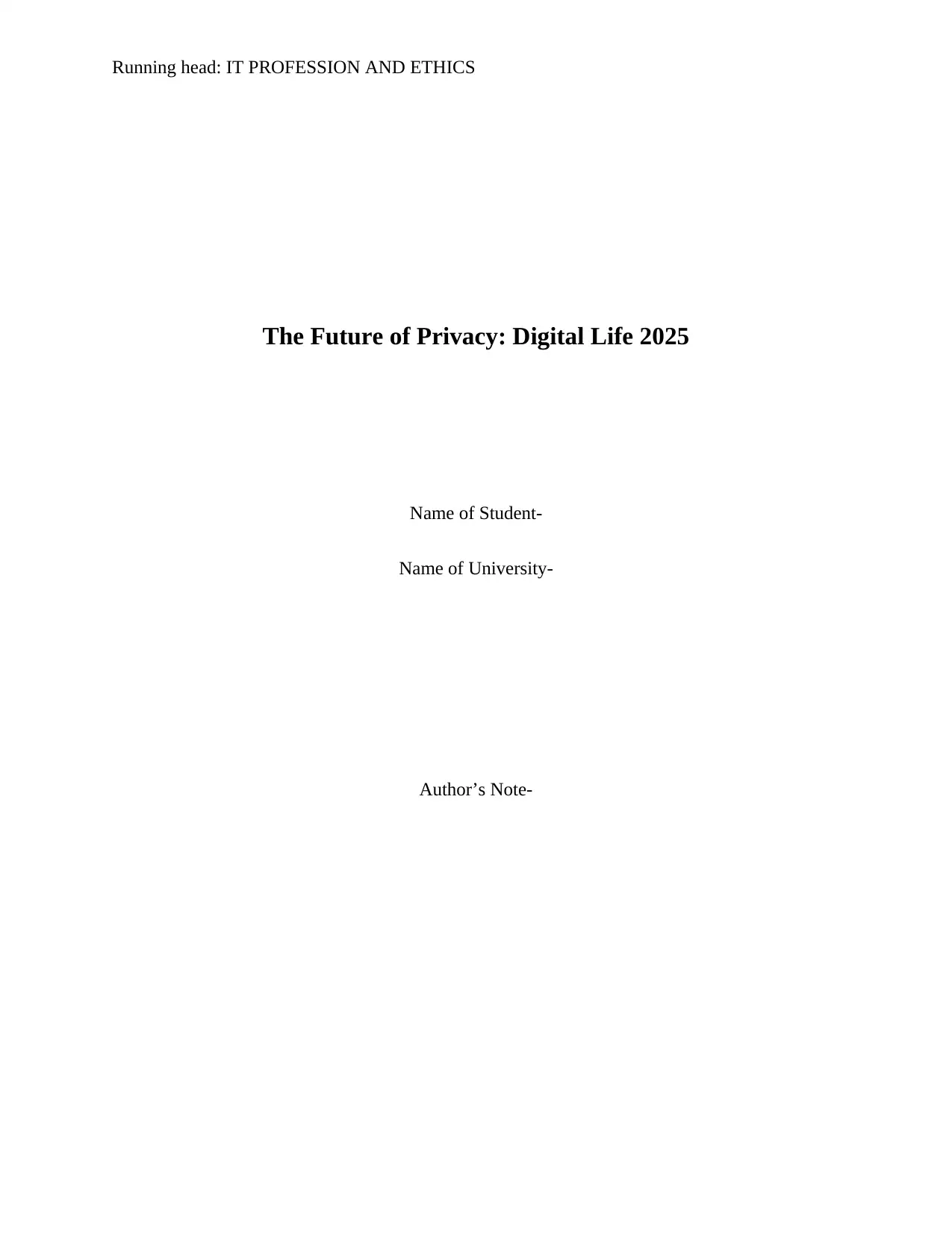
Running head: IT PROFESSION AND ETHICS
The Future of Privacy: Digital Life 2025
Name of Student-
Name of University-
Author’s Note-
The Future of Privacy: Digital Life 2025
Name of Student-
Name of University-
Author’s Note-
Paraphrase This Document
Need a fresh take? Get an instant paraphrase of this document with our AI Paraphraser
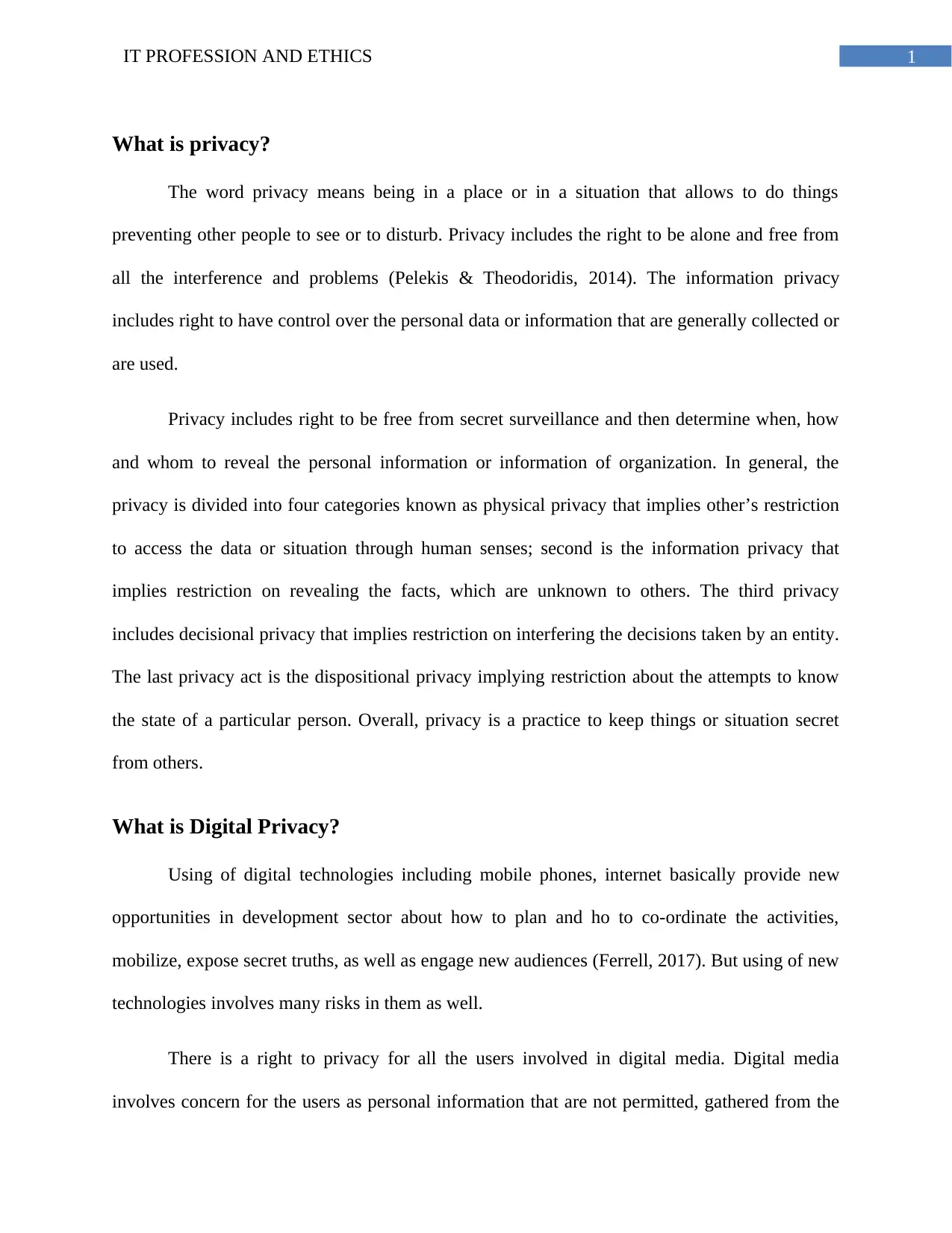
1IT PROFESSION AND ETHICS
What is privacy?
The word privacy means being in a place or in a situation that allows to do things
preventing other people to see or to disturb. Privacy includes the right to be alone and free from
all the interference and problems (Pelekis & Theodoridis, 2014). The information privacy
includes right to have control over the personal data or information that are generally collected or
are used.
Privacy includes right to be free from secret surveillance and then determine when, how
and whom to reveal the personal information or information of organization. In general, the
privacy is divided into four categories known as physical privacy that implies other’s restriction
to access the data or situation through human senses; second is the information privacy that
implies restriction on revealing the facts, which are unknown to others. The third privacy
includes decisional privacy that implies restriction on interfering the decisions taken by an entity.
The last privacy act is the dispositional privacy implying restriction about the attempts to know
the state of a particular person. Overall, privacy is a practice to keep things or situation secret
from others.
What is Digital Privacy?
Using of digital technologies including mobile phones, internet basically provide new
opportunities in development sector about how to plan and ho to co-ordinate the activities,
mobilize, expose secret truths, as well as engage new audiences (Ferrell, 2017). But using of new
technologies involves many risks in them as well.
There is a right to privacy for all the users involved in digital media. Digital media
involves concern for the users as personal information that are not permitted, gathered from the
What is privacy?
The word privacy means being in a place or in a situation that allows to do things
preventing other people to see or to disturb. Privacy includes the right to be alone and free from
all the interference and problems (Pelekis & Theodoridis, 2014). The information privacy
includes right to have control over the personal data or information that are generally collected or
are used.
Privacy includes right to be free from secret surveillance and then determine when, how
and whom to reveal the personal information or information of organization. In general, the
privacy is divided into four categories known as physical privacy that implies other’s restriction
to access the data or situation through human senses; second is the information privacy that
implies restriction on revealing the facts, which are unknown to others. The third privacy
includes decisional privacy that implies restriction on interfering the decisions taken by an entity.
The last privacy act is the dispositional privacy implying restriction about the attempts to know
the state of a particular person. Overall, privacy is a practice to keep things or situation secret
from others.
What is Digital Privacy?
Using of digital technologies including mobile phones, internet basically provide new
opportunities in development sector about how to plan and ho to co-ordinate the activities,
mobilize, expose secret truths, as well as engage new audiences (Ferrell, 2017). But using of new
technologies involves many risks in them as well.
There is a right to privacy for all the users involved in digital media. Digital media
involves concern for the users as personal information that are not permitted, gathered from the
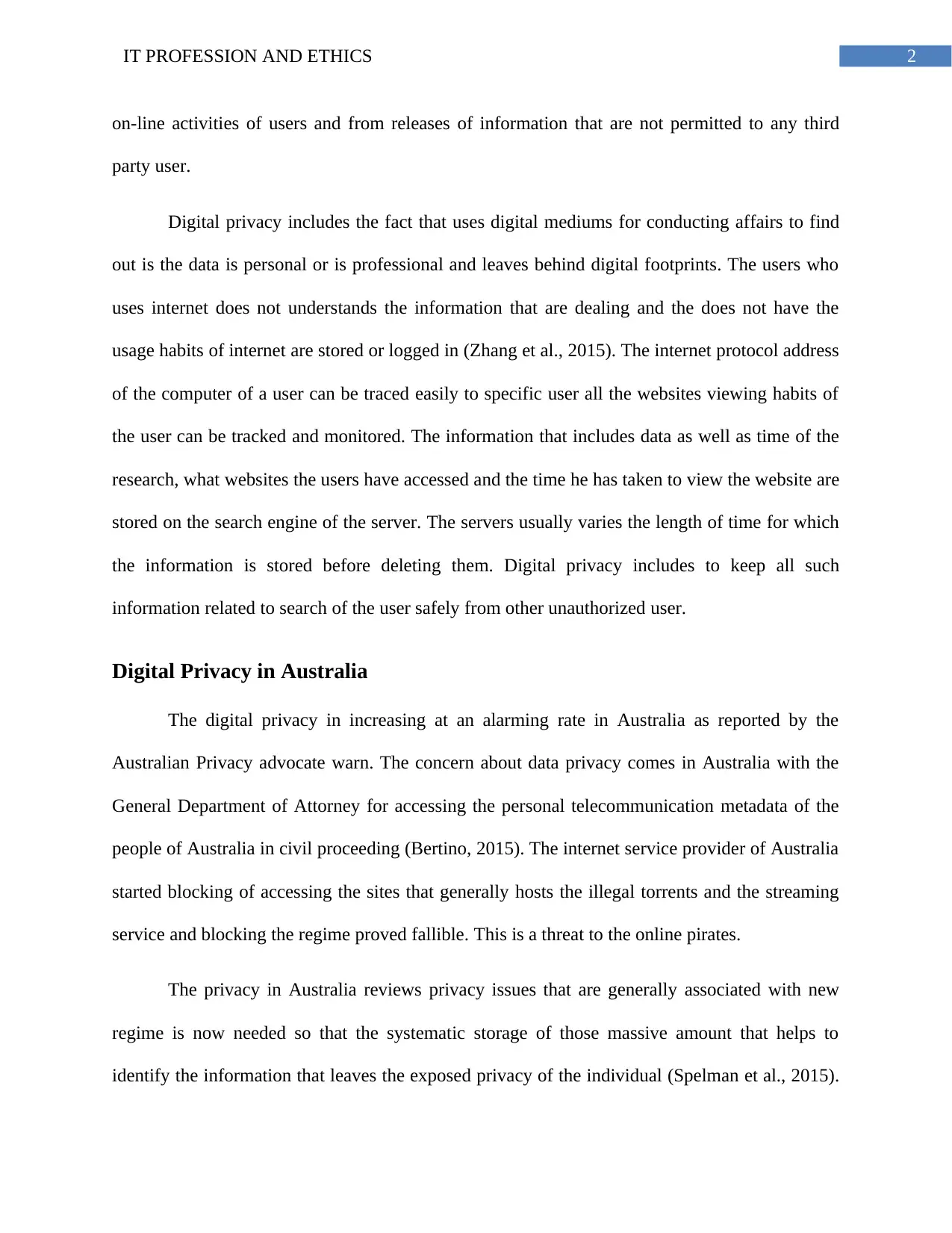
2IT PROFESSION AND ETHICS
on-line activities of users and from releases of information that are not permitted to any third
party user.
Digital privacy includes the fact that uses digital mediums for conducting affairs to find
out is the data is personal or is professional and leaves behind digital footprints. The users who
uses internet does not understands the information that are dealing and the does not have the
usage habits of internet are stored or logged in (Zhang et al., 2015). The internet protocol address
of the computer of a user can be traced easily to specific user all the websites viewing habits of
the user can be tracked and monitored. The information that includes data as well as time of the
research, what websites the users have accessed and the time he has taken to view the website are
stored on the search engine of the server. The servers usually varies the length of time for which
the information is stored before deleting them. Digital privacy includes to keep all such
information related to search of the user safely from other unauthorized user.
Digital Privacy in Australia
The digital privacy in increasing at an alarming rate in Australia as reported by the
Australian Privacy advocate warn. The concern about data privacy comes in Australia with the
General Department of Attorney for accessing the personal telecommunication metadata of the
people of Australia in civil proceeding (Bertino, 2015). The internet service provider of Australia
started blocking of accessing the sites that generally hosts the illegal torrents and the streaming
service and blocking the regime proved fallible. This is a threat to the online pirates.
The privacy in Australia reviews privacy issues that are generally associated with new
regime is now needed so that the systematic storage of those massive amount that helps to
identify the information that leaves the exposed privacy of the individual (Spelman et al., 2015).
on-line activities of users and from releases of information that are not permitted to any third
party user.
Digital privacy includes the fact that uses digital mediums for conducting affairs to find
out is the data is personal or is professional and leaves behind digital footprints. The users who
uses internet does not understands the information that are dealing and the does not have the
usage habits of internet are stored or logged in (Zhang et al., 2015). The internet protocol address
of the computer of a user can be traced easily to specific user all the websites viewing habits of
the user can be tracked and monitored. The information that includes data as well as time of the
research, what websites the users have accessed and the time he has taken to view the website are
stored on the search engine of the server. The servers usually varies the length of time for which
the information is stored before deleting them. Digital privacy includes to keep all such
information related to search of the user safely from other unauthorized user.
Digital Privacy in Australia
The digital privacy in increasing at an alarming rate in Australia as reported by the
Australian Privacy advocate warn. The concern about data privacy comes in Australia with the
General Department of Attorney for accessing the personal telecommunication metadata of the
people of Australia in civil proceeding (Bertino, 2015). The internet service provider of Australia
started blocking of accessing the sites that generally hosts the illegal torrents and the streaming
service and blocking the regime proved fallible. This is a threat to the online pirates.
The privacy in Australia reviews privacy issues that are generally associated with new
regime is now needed so that the systematic storage of those massive amount that helps to
identify the information that leaves the exposed privacy of the individual (Spelman et al., 2015).
⊘ This is a preview!⊘
Do you want full access?
Subscribe today to unlock all pages.

Trusted by 1+ million students worldwide
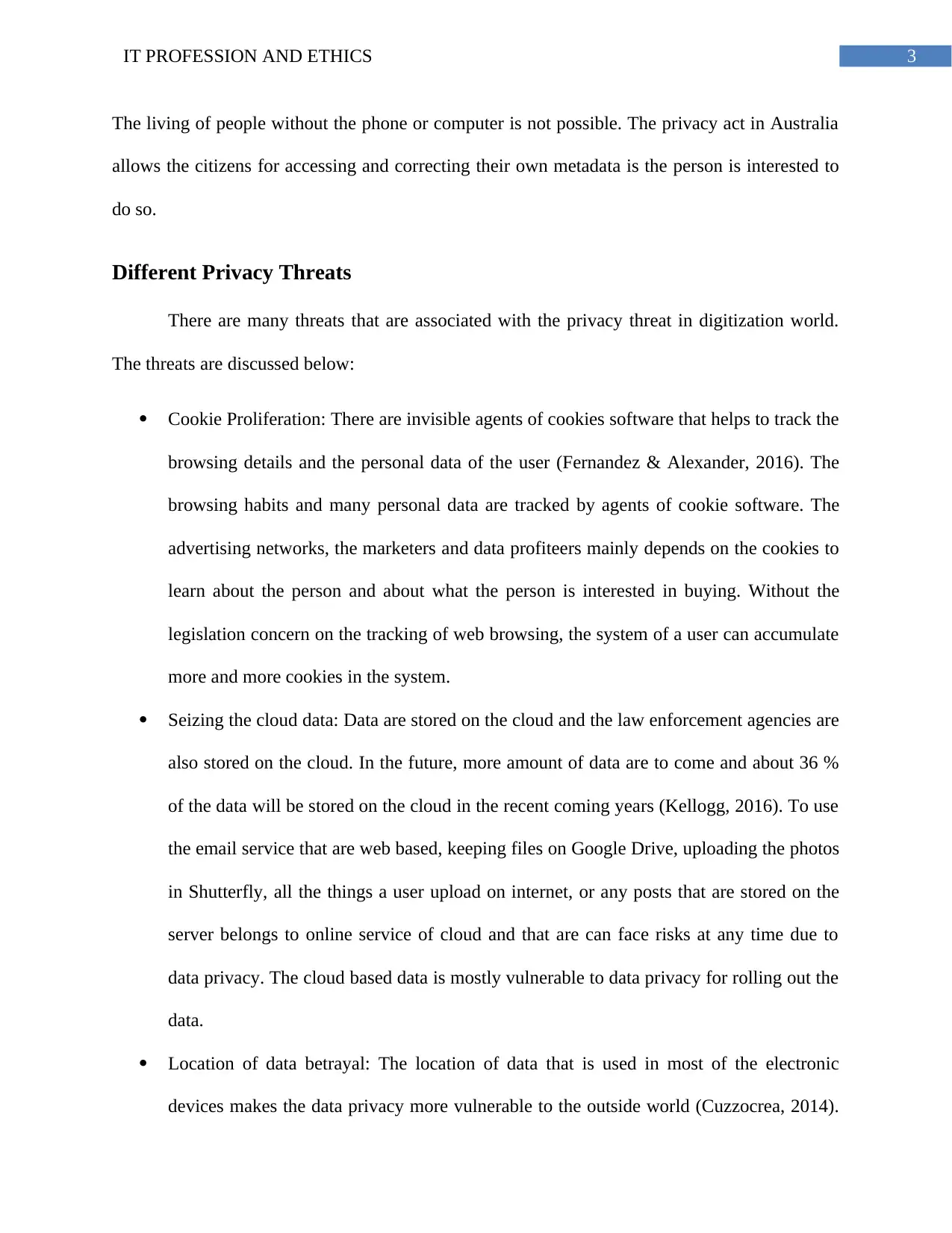
3IT PROFESSION AND ETHICS
The living of people without the phone or computer is not possible. The privacy act in Australia
allows the citizens for accessing and correcting their own metadata is the person is interested to
do so.
Different Privacy Threats
There are many threats that are associated with the privacy threat in digitization world.
The threats are discussed below:
Cookie Proliferation: There are invisible agents of cookies software that helps to track the
browsing details and the personal data of the user (Fernandez & Alexander, 2016). The
browsing habits and many personal data are tracked by agents of cookie software. The
advertising networks, the marketers and data profiteers mainly depends on the cookies to
learn about the person and about what the person is interested in buying. Without the
legislation concern on the tracking of web browsing, the system of a user can accumulate
more and more cookies in the system.
Seizing the cloud data: Data are stored on the cloud and the law enforcement agencies are
also stored on the cloud. In the future, more amount of data are to come and about 36 %
of the data will be stored on the cloud in the recent coming years (Kellogg, 2016). To use
the email service that are web based, keeping files on Google Drive, uploading the photos
in Shutterfly, all the things a user upload on internet, or any posts that are stored on the
server belongs to online service of cloud and that are can face risks at any time due to
data privacy. The cloud based data is mostly vulnerable to data privacy for rolling out the
data.
Location of data betrayal: The location of data that is used in most of the electronic
devices makes the data privacy more vulnerable to the outside world (Cuzzocrea, 2014).
The living of people without the phone or computer is not possible. The privacy act in Australia
allows the citizens for accessing and correcting their own metadata is the person is interested to
do so.
Different Privacy Threats
There are many threats that are associated with the privacy threat in digitization world.
The threats are discussed below:
Cookie Proliferation: There are invisible agents of cookies software that helps to track the
browsing details and the personal data of the user (Fernandez & Alexander, 2016). The
browsing habits and many personal data are tracked by agents of cookie software. The
advertising networks, the marketers and data profiteers mainly depends on the cookies to
learn about the person and about what the person is interested in buying. Without the
legislation concern on the tracking of web browsing, the system of a user can accumulate
more and more cookies in the system.
Seizing the cloud data: Data are stored on the cloud and the law enforcement agencies are
also stored on the cloud. In the future, more amount of data are to come and about 36 %
of the data will be stored on the cloud in the recent coming years (Kellogg, 2016). To use
the email service that are web based, keeping files on Google Drive, uploading the photos
in Shutterfly, all the things a user upload on internet, or any posts that are stored on the
server belongs to online service of cloud and that are can face risks at any time due to
data privacy. The cloud based data is mostly vulnerable to data privacy for rolling out the
data.
Location of data betrayal: The location of data that is used in most of the electronic
devices makes the data privacy more vulnerable to the outside world (Cuzzocrea, 2014).
Paraphrase This Document
Need a fresh take? Get an instant paraphrase of this document with our AI Paraphraser
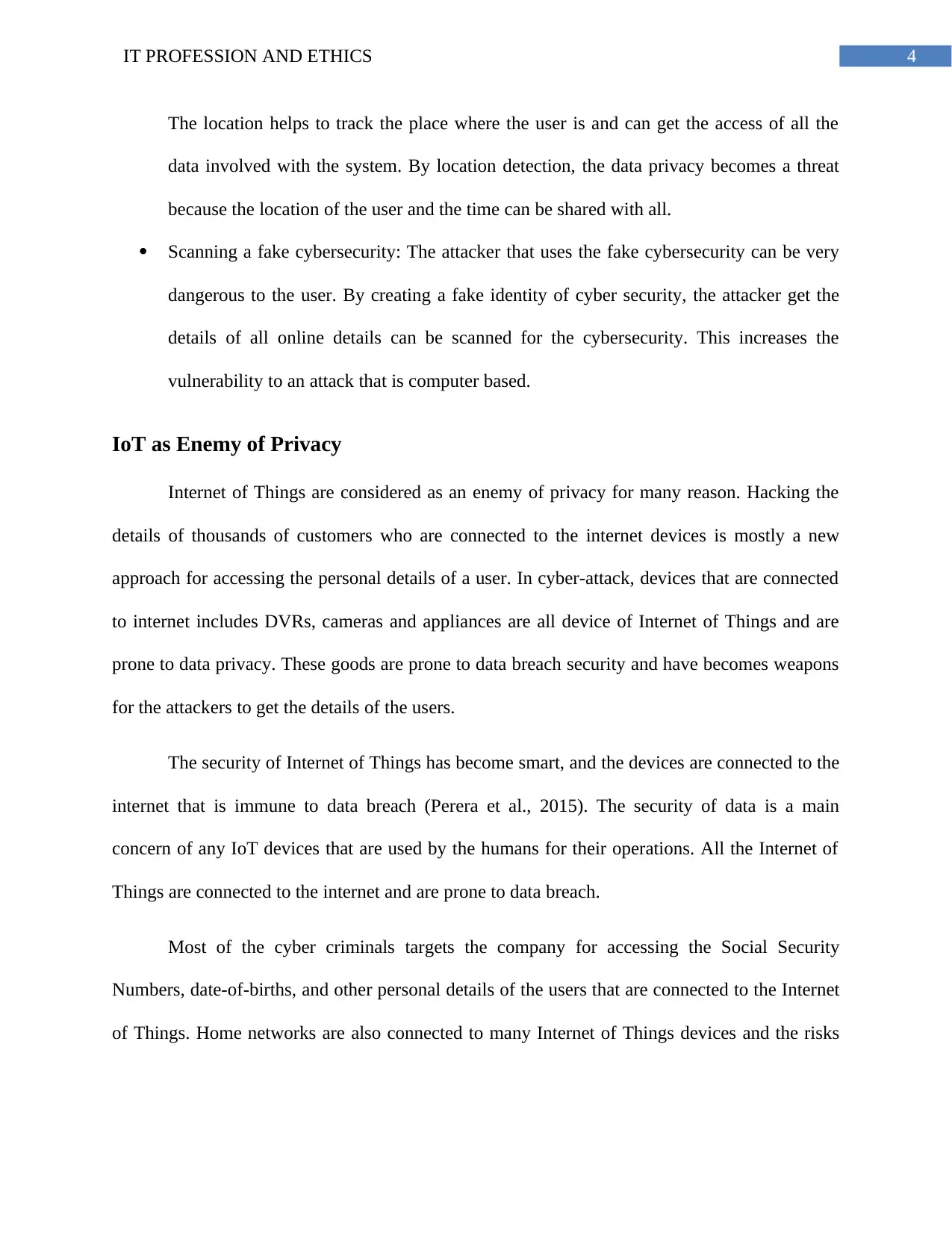
4IT PROFESSION AND ETHICS
The location helps to track the place where the user is and can get the access of all the
data involved with the system. By location detection, the data privacy becomes a threat
because the location of the user and the time can be shared with all.
Scanning a fake cybersecurity: The attacker that uses the fake cybersecurity can be very
dangerous to the user. By creating a fake identity of cyber security, the attacker get the
details of all online details can be scanned for the cybersecurity. This increases the
vulnerability to an attack that is computer based.
IoT as Enemy of Privacy
Internet of Things are considered as an enemy of privacy for many reason. Hacking the
details of thousands of customers who are connected to the internet devices is mostly a new
approach for accessing the personal details of a user. In cyber-attack, devices that are connected
to internet includes DVRs, cameras and appliances are all device of Internet of Things and are
prone to data privacy. These goods are prone to data breach security and have becomes weapons
for the attackers to get the details of the users.
The security of Internet of Things has become smart, and the devices are connected to the
internet that is immune to data breach (Perera et al., 2015). The security of data is a main
concern of any IoT devices that are used by the humans for their operations. All the Internet of
Things are connected to the internet and are prone to data breach.
Most of the cyber criminals targets the company for accessing the Social Security
Numbers, date-of-births, and other personal details of the users that are connected to the Internet
of Things. Home networks are also connected to many Internet of Things devices and the risks
The location helps to track the place where the user is and can get the access of all the
data involved with the system. By location detection, the data privacy becomes a threat
because the location of the user and the time can be shared with all.
Scanning a fake cybersecurity: The attacker that uses the fake cybersecurity can be very
dangerous to the user. By creating a fake identity of cyber security, the attacker get the
details of all online details can be scanned for the cybersecurity. This increases the
vulnerability to an attack that is computer based.
IoT as Enemy of Privacy
Internet of Things are considered as an enemy of privacy for many reason. Hacking the
details of thousands of customers who are connected to the internet devices is mostly a new
approach for accessing the personal details of a user. In cyber-attack, devices that are connected
to internet includes DVRs, cameras and appliances are all device of Internet of Things and are
prone to data privacy. These goods are prone to data breach security and have becomes weapons
for the attackers to get the details of the users.
The security of Internet of Things has become smart, and the devices are connected to the
internet that is immune to data breach (Perera et al., 2015). The security of data is a main
concern of any IoT devices that are used by the humans for their operations. All the Internet of
Things are connected to the internet and are prone to data breach.
Most of the cyber criminals targets the company for accessing the Social Security
Numbers, date-of-births, and other personal details of the users that are connected to the Internet
of Things. Home networks are also connected to many Internet of Things devices and the risks
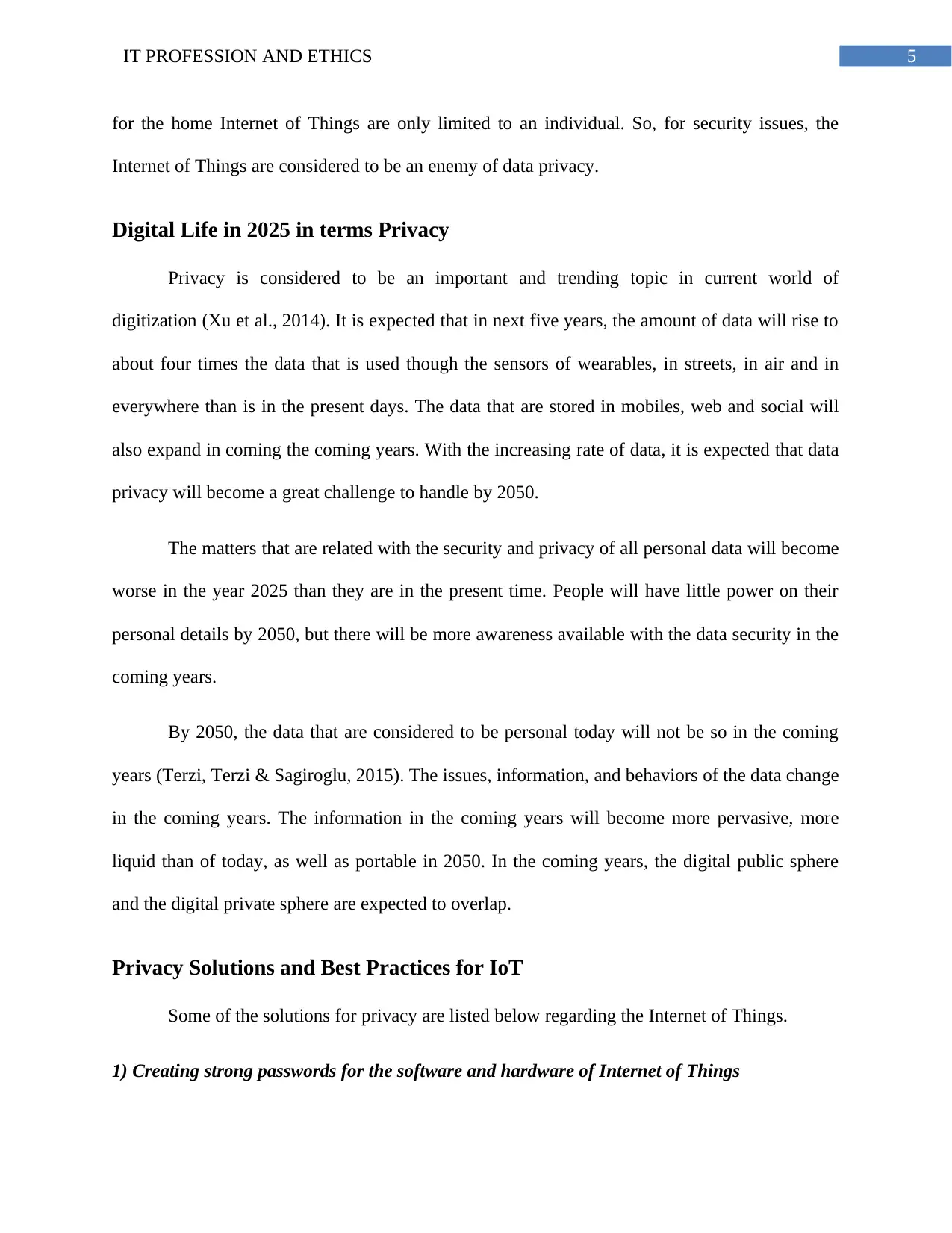
5IT PROFESSION AND ETHICS
for the home Internet of Things are only limited to an individual. So, for security issues, the
Internet of Things are considered to be an enemy of data privacy.
Digital Life in 2025 in terms Privacy
Privacy is considered to be an important and trending topic in current world of
digitization (Xu et al., 2014). It is expected that in next five years, the amount of data will rise to
about four times the data that is used though the sensors of wearables, in streets, in air and in
everywhere than is in the present days. The data that are stored in mobiles, web and social will
also expand in coming the coming years. With the increasing rate of data, it is expected that data
privacy will become a great challenge to handle by 2050.
The matters that are related with the security and privacy of all personal data will become
worse in the year 2025 than they are in the present time. People will have little power on their
personal details by 2050, but there will be more awareness available with the data security in the
coming years.
By 2050, the data that are considered to be personal today will not be so in the coming
years (Terzi, Terzi & Sagiroglu, 2015). The issues, information, and behaviors of the data change
in the coming years. The information in the coming years will become more pervasive, more
liquid than of today, as well as portable in 2050. In the coming years, the digital public sphere
and the digital private sphere are expected to overlap.
Privacy Solutions and Best Practices for IoT
Some of the solutions for privacy are listed below regarding the Internet of Things.
1) Creating strong passwords for the software and hardware of Internet of Things
for the home Internet of Things are only limited to an individual. So, for security issues, the
Internet of Things are considered to be an enemy of data privacy.
Digital Life in 2025 in terms Privacy
Privacy is considered to be an important and trending topic in current world of
digitization (Xu et al., 2014). It is expected that in next five years, the amount of data will rise to
about four times the data that is used though the sensors of wearables, in streets, in air and in
everywhere than is in the present days. The data that are stored in mobiles, web and social will
also expand in coming the coming years. With the increasing rate of data, it is expected that data
privacy will become a great challenge to handle by 2050.
The matters that are related with the security and privacy of all personal data will become
worse in the year 2025 than they are in the present time. People will have little power on their
personal details by 2050, but there will be more awareness available with the data security in the
coming years.
By 2050, the data that are considered to be personal today will not be so in the coming
years (Terzi, Terzi & Sagiroglu, 2015). The issues, information, and behaviors of the data change
in the coming years. The information in the coming years will become more pervasive, more
liquid than of today, as well as portable in 2050. In the coming years, the digital public sphere
and the digital private sphere are expected to overlap.
Privacy Solutions and Best Practices for IoT
Some of the solutions for privacy are listed below regarding the Internet of Things.
1) Creating strong passwords for the software and hardware of Internet of Things
⊘ This is a preview!⊘
Do you want full access?
Subscribe today to unlock all pages.

Trusted by 1+ million students worldwide
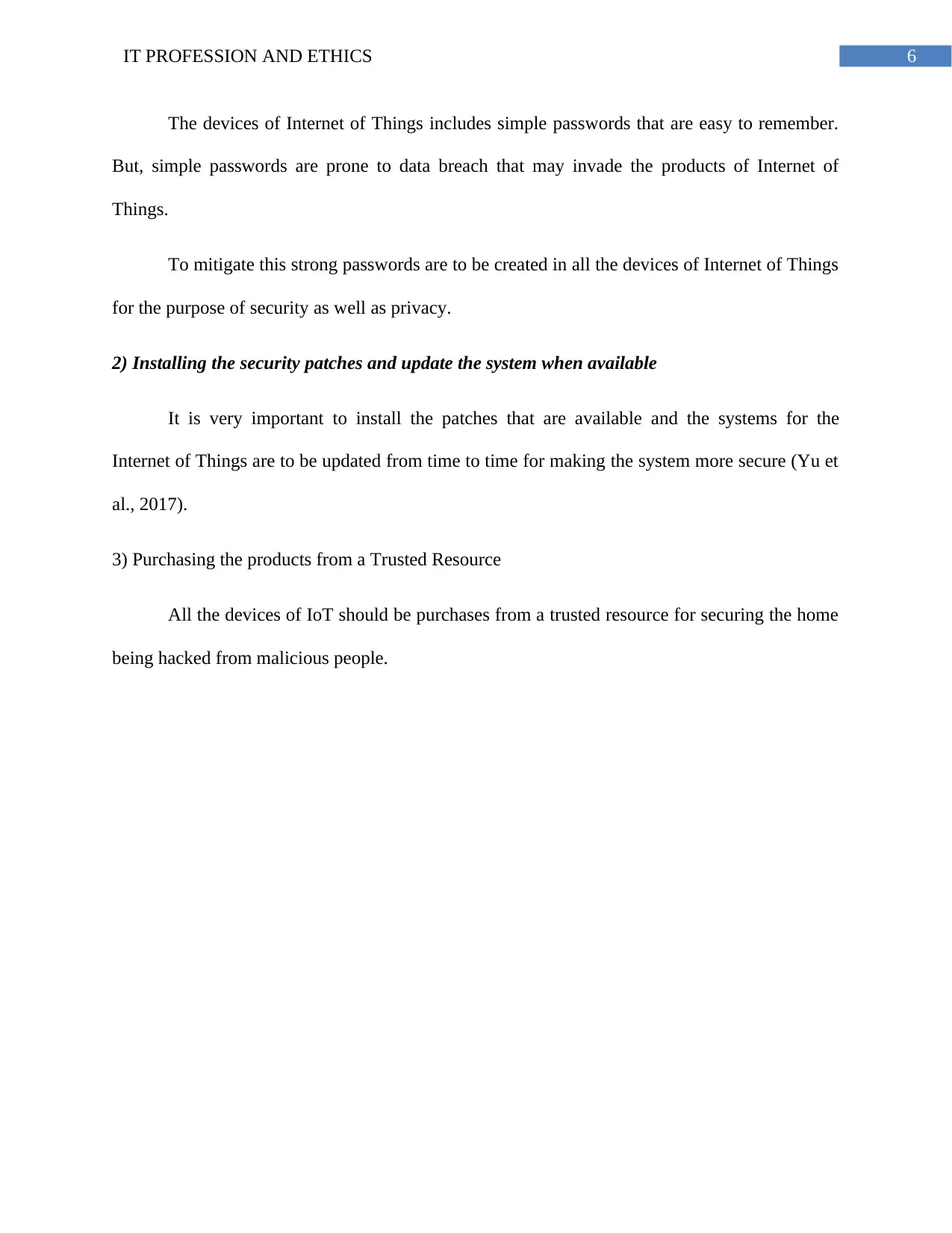
6IT PROFESSION AND ETHICS
The devices of Internet of Things includes simple passwords that are easy to remember.
But, simple passwords are prone to data breach that may invade the products of Internet of
Things.
To mitigate this strong passwords are to be created in all the devices of Internet of Things
for the purpose of security as well as privacy.
2) Installing the security patches and update the system when available
It is very important to install the patches that are available and the systems for the
Internet of Things are to be updated from time to time for making the system more secure (Yu et
al., 2017).
3) Purchasing the products from a Trusted Resource
All the devices of IoT should be purchases from a trusted resource for securing the home
being hacked from malicious people.
The devices of Internet of Things includes simple passwords that are easy to remember.
But, simple passwords are prone to data breach that may invade the products of Internet of
Things.
To mitigate this strong passwords are to be created in all the devices of Internet of Things
for the purpose of security as well as privacy.
2) Installing the security patches and update the system when available
It is very important to install the patches that are available and the systems for the
Internet of Things are to be updated from time to time for making the system more secure (Yu et
al., 2017).
3) Purchasing the products from a Trusted Resource
All the devices of IoT should be purchases from a trusted resource for securing the home
being hacked from malicious people.
Paraphrase This Document
Need a fresh take? Get an instant paraphrase of this document with our AI Paraphraser
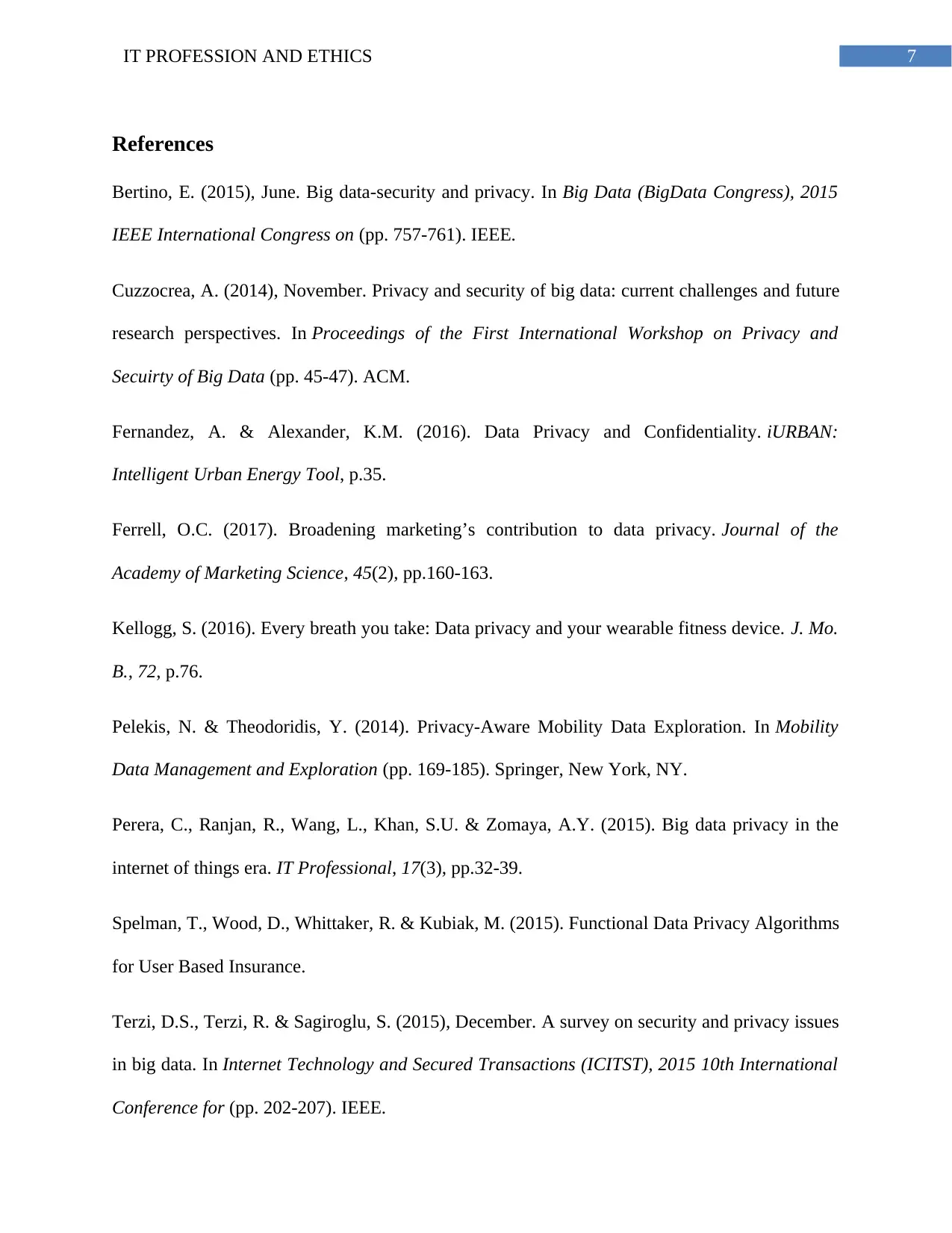
7IT PROFESSION AND ETHICS
References
Bertino, E. (2015), June. Big data-security and privacy. In Big Data (BigData Congress), 2015
IEEE International Congress on (pp. 757-761). IEEE.
Cuzzocrea, A. (2014), November. Privacy and security of big data: current challenges and future
research perspectives. In Proceedings of the First International Workshop on Privacy and
Secuirty of Big Data (pp. 45-47). ACM.
Fernandez, A. & Alexander, K.M. (2016). Data Privacy and Confidentiality. iURBAN:
Intelligent Urban Energy Tool, p.35.
Ferrell, O.C. (2017). Broadening marketing’s contribution to data privacy. Journal of the
Academy of Marketing Science, 45(2), pp.160-163.
Kellogg, S. (2016). Every breath you take: Data privacy and your wearable fitness device. J. Mo.
B., 72, p.76.
Pelekis, N. & Theodoridis, Y. (2014). Privacy-Aware Mobility Data Exploration. In Mobility
Data Management and Exploration (pp. 169-185). Springer, New York, NY.
Perera, C., Ranjan, R., Wang, L., Khan, S.U. & Zomaya, A.Y. (2015). Big data privacy in the
internet of things era. IT Professional, 17(3), pp.32-39.
Spelman, T., Wood, D., Whittaker, R. & Kubiak, M. (2015). Functional Data Privacy Algorithms
for User Based Insurance.
Terzi, D.S., Terzi, R. & Sagiroglu, S. (2015), December. A survey on security and privacy issues
in big data. In Internet Technology and Secured Transactions (ICITST), 2015 10th International
Conference for (pp. 202-207). IEEE.
References
Bertino, E. (2015), June. Big data-security and privacy. In Big Data (BigData Congress), 2015
IEEE International Congress on (pp. 757-761). IEEE.
Cuzzocrea, A. (2014), November. Privacy and security of big data: current challenges and future
research perspectives. In Proceedings of the First International Workshop on Privacy and
Secuirty of Big Data (pp. 45-47). ACM.
Fernandez, A. & Alexander, K.M. (2016). Data Privacy and Confidentiality. iURBAN:
Intelligent Urban Energy Tool, p.35.
Ferrell, O.C. (2017). Broadening marketing’s contribution to data privacy. Journal of the
Academy of Marketing Science, 45(2), pp.160-163.
Kellogg, S. (2016). Every breath you take: Data privacy and your wearable fitness device. J. Mo.
B., 72, p.76.
Pelekis, N. & Theodoridis, Y. (2014). Privacy-Aware Mobility Data Exploration. In Mobility
Data Management and Exploration (pp. 169-185). Springer, New York, NY.
Perera, C., Ranjan, R., Wang, L., Khan, S.U. & Zomaya, A.Y. (2015). Big data privacy in the
internet of things era. IT Professional, 17(3), pp.32-39.
Spelman, T., Wood, D., Whittaker, R. & Kubiak, M. (2015). Functional Data Privacy Algorithms
for User Based Insurance.
Terzi, D.S., Terzi, R. & Sagiroglu, S. (2015), December. A survey on security and privacy issues
in big data. In Internet Technology and Secured Transactions (ICITST), 2015 10th International
Conference for (pp. 202-207). IEEE.
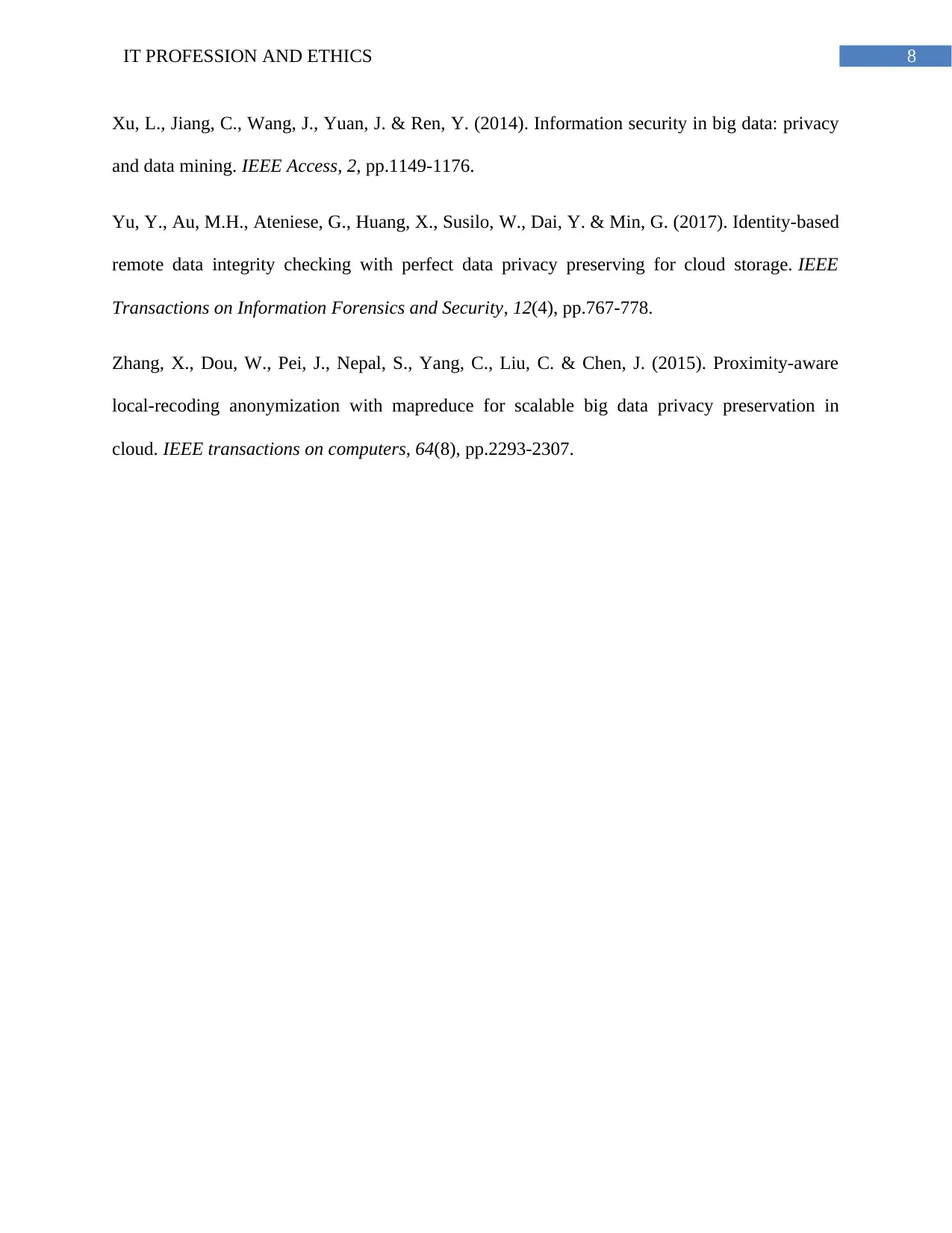
8IT PROFESSION AND ETHICS
Xu, L., Jiang, C., Wang, J., Yuan, J. & Ren, Y. (2014). Information security in big data: privacy
and data mining. IEEE Access, 2, pp.1149-1176.
Yu, Y., Au, M.H., Ateniese, G., Huang, X., Susilo, W., Dai, Y. & Min, G. (2017). Identity-based
remote data integrity checking with perfect data privacy preserving for cloud storage. IEEE
Transactions on Information Forensics and Security, 12(4), pp.767-778.
Zhang, X., Dou, W., Pei, J., Nepal, S., Yang, C., Liu, C. & Chen, J. (2015). Proximity-aware
local-recoding anonymization with mapreduce for scalable big data privacy preservation in
cloud. IEEE transactions on computers, 64(8), pp.2293-2307.
Xu, L., Jiang, C., Wang, J., Yuan, J. & Ren, Y. (2014). Information security in big data: privacy
and data mining. IEEE Access, 2, pp.1149-1176.
Yu, Y., Au, M.H., Ateniese, G., Huang, X., Susilo, W., Dai, Y. & Min, G. (2017). Identity-based
remote data integrity checking with perfect data privacy preserving for cloud storage. IEEE
Transactions on Information Forensics and Security, 12(4), pp.767-778.
Zhang, X., Dou, W., Pei, J., Nepal, S., Yang, C., Liu, C. & Chen, J. (2015). Proximity-aware
local-recoding anonymization with mapreduce for scalable big data privacy preservation in
cloud. IEEE transactions on computers, 64(8), pp.2293-2307.
⊘ This is a preview!⊘
Do you want full access?
Subscribe today to unlock all pages.

Trusted by 1+ million students worldwide
1 out of 9
Related Documents
Your All-in-One AI-Powered Toolkit for Academic Success.
+13062052269
info@desklib.com
Available 24*7 on WhatsApp / Email
![[object Object]](/_next/static/media/star-bottom.7253800d.svg)
Unlock your academic potential
Copyright © 2020–2025 A2Z Services. All Rights Reserved. Developed and managed by ZUCOL.





